
Animal Prints
Linda Wain is showing off her "roar" talent in her exhibition at Evergreen House in Blackden Close, Belper. More than 150 prints are on show at the exhibition, featuring wildlife ranging from lions to hedgehogs.
Linda said "I used to work for Royal Crown Derby painting flowers. When I left I began to paint birds and it progressed from there."
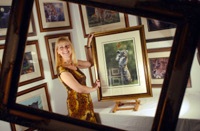

This article appeared in the Derby Evening Telegraph on November 21st 2003.
Picture: Jane Barlow
Belper wildlife artist Linda Wain has broken a personal record during a charity auction for one of her masterpieces.
Linda is pictured with her painting, A Tiger's Care, which fetched an impressive £700 during a charity ball at Broxbourne, Berkshire, last week. The ball raised thousands for the 21st Century Tiger Campaign and the newly formed Wildlife Heritage Foundation, two charities close to Linda's heart as a wildlife artist.
Linda of Blackden Close, Belper said "My motto is that I make my living from wildlife and I like to give something back. It was an unbelievable price for one of my prints".
TV antiques expert Eric Knowles was the guest auctioneer.
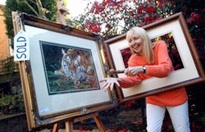
This article appeared in the Derby Evening Telegraph on October 31st 2003.
Picture: Jane Barlow


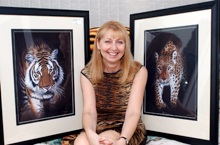
A wildlife artist who is famed for her paintings of exotic beasts will be turning her thoughts to slightly tamer animals from today.
Linda Wain, of Blackden Close, Belper has been a professional artist for 11 years. She is hosting a Christmas exhibition today, tomorrow and Monday and will be holding a charity raffle in aid of two Derbyshire animal shelters.
Proceeds of the raffle will be split between Prickly's Patch, a hedgehog rescue centre in Riddings, and the Just for Dogs rescue centre in North Lane Brailsford. Linda said " Both charities do a lot of good work locally and I'm proud to be associated with them as their patron..
This article appeared in the Derby Evening Telegraph on November 22nd 2002.
Picture: Jane Barlow
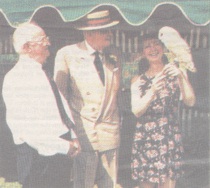
Belper Wildlife Artist Linda Wain shows off her pet barn owl, Minty, to the late Duke of Devonshire (centre) and Philip Matthews.
Linda was a guest at the Shottle Hall Victorian garden party which was held last Saturday. As well as meeting the Duke, she displayed two of her original paintings and talked about her work with Tigers.
Proceeds from the event will go towards buying new doors at Shottle Church
This article appeared in the Belper News

Linda’s paintings of tigers a roaring success
Linda Wain started her career as an artist at Royal Crown Derby, before becoming an internationally renowned wildlife artist. Today, she is due to return to the factory to talk about her work for fund-raising organisations dedicated to saving tigers around the world. Simon Burch reports.
Waiting for wildlife artist Linda Wain to finish one or her twice - weekly classes downstairs, I resort to counting just how many of her own pictures hung on the wall around me. There are 66 on this floor, and yet there are two more floors to look at! They are all different sizes, but they all feature one type of animal or another save for a few paintings of flowers. There are lions, swans, blue tits, otters and owls in a variety of colourful settings. There are also tigers, paintings for which Linda is particularly well known, and they swim, glower and growl from within their frames. Linda's husband, Kevin, walks in with a cup of coffee. There are even more pictures downstairs, he says, and upstairs in Linda's studio.
One by one, members of the prolific Linda's art class file out clutching their folders and soon she is ready to see me. Linda Wain, from Belper, Derbyshire has been a professional artist for 10 years and her publicity material (prepared by Kevin, her manager-cum-agent) says she is now regarded as one of Britain's leading wildlife artists. So respected is she that she has been accepted into the Society of Feline Artists — a rare honour — and countless people have bought and admired her work. It is the fine detail of Linda's paintings which is her hallmark. Every single one of her pieces is as fine up close as it is from further away. Standing right next to them you almost feel you could touch the animals and stroke soft fur.
When she paints a tiger, Linda faithfully reproduces every single strand of fur, every single whisker, every single marking. When she does birds, it is the same with the feathers. I've always been a fine detail artist, Linda says. It's something I seem to have had within me from the age of seven or eight. I've always had to make things look as real as possible. I have experimented throughout the years with different styles, but I always come back to the detail. This instinctive obsession with incorporating every last feature gave Linda a head start in her first job as an artist at Royal Crown Derby. Born in the city, Linda started at the bone china makers at the age of 15, in 1965. I'd always painted before that but they trained me to paint in fine detail, which in the end was perfect for me. It was just what I needed without realising it. She started by painting the company's Imari pattern on plates, learning her trade as she went along.
The lady who taught us started by giving us a white plate and we had to balance it on our little fingers and draw straight lines on it, she recalls. Then they started to teach how to load a brush with paint in a certain way and use just the right amount of water. Things like that all make a big difference and it all went along with training in how to hold your hand steady.
Linda's mastery of the technique saw her graduate from plates onto figurines and then onto jewellery and the figures of birds. She was one of the finest artists at the Osmaston Road factory, but I wonder if the job recreating the same appearance on countless figures was boring. Not so, she says. You can use your imagination on many pieces, so if you're doing a figurine you can make up the pattern yourself and be creative with your colours. If you're doing a bird like a blue tit or a robin you've got to make it look like a bird so they're a little more limited but there's always one thing, like the ground they're perched on, so you can play around with that.

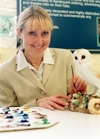
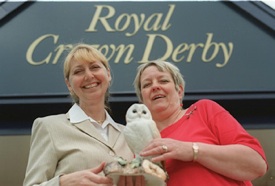
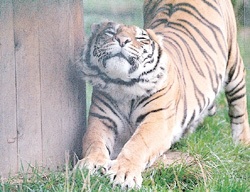



This article appeared in the Derby Evening Telegraph
on November 18th 2000



Linda with Virginia McKenna
( actress and patron of Born Free Foundation )
Linda with Will Travers
( CEO to the Born Free Foundation )

Linda with Linda Lusardi (actress) at the "Stars and their Stripe" ball.



Linda with Gillian Taylforth (actress) at the "Stars and their Stripe" ball.
Linda with Nick Rhodes of
Duran Duran.
Linda with Li Quan Founding Director of Save China's Tigers.